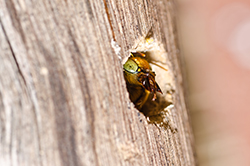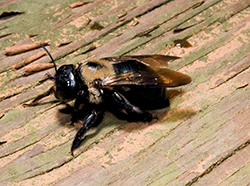Carpenter Bee Prevention – Why is it important?
 Carpenter bee females create a 1/2-inch diameter hole in soft, dry wood and can deepen the hole by as much as an additional inch each week. The female then creates six or seven cells in the hole stocked with nectar and pollen for her larva. So, a typical carpenter bee hole can be up to 10 inches long…the first year.
Carpenter bee females create a 1/2-inch diameter hole in soft, dry wood and can deepen the hole by as much as an additional inch each week. The female then creates six or seven cells in the hole stocked with nectar and pollen for her larva. So, a typical carpenter bee hole can be up to 10 inches long…the first year.
Carpenter bees return in subsequent years and continue to expand the holes which can grow to become 3 or more feet long. That in itself can represent pretty extensive damage to wooden structures. But it doesn’t stop there.
It happens that woodpeckers especially love carpenter bee larva. They cause much more damage to the wood in their attempt to get to the larva. Imagine the damage a woodpecker could cause to a support beam in it’s attempt to get to six or seven carpenter bee larva that are located between one and three feet deep inside a carpenter bee nest!
This is why if you see a carpenter bee hole, you don’t want to ignore it. And by all means you want to prevent carpenter bees from beginning a nest in your home in the first place.
Carpenter Bee Prevention – Where do they love to drill?
 First of all, know what kind of wood carpenter bees like to drill. Their favorite is unprotected (unfinished) soft wood. They must love it that the frames of most homes are constructed with spruce, fir or pine–all soft woods.
First of all, know what kind of wood carpenter bees like to drill. Their favorite is unprotected (unfinished) soft wood. They must love it that the frames of most homes are constructed with spruce, fir or pine–all soft woods.
So, thoroughly inspect the exterior of your home, your deck, wooden play structures and wooden fences. Are there any places that are unfinished or where the finish has become worn and thin? Look especially in protected wooden areas such as under decks, and soffits behind gutters.
Carpenter Bee Prevention – What to do?
Sand and paint all the types of areas carpenter bees are likely to attack. Fill in any cracks or crevices. If you know a particular area has been previously drilled by carpenter bees and is especially susceptible to attack, you may want to cover the softwood with flashing or metal window screen.
Stop up any old carpenter bee holes with wooden dowels in order to discourage woodpeckers, or the return of the next generation of carpenter bees. But be certain that there are no living carpenter bees or larva in the hole before you seal it. If you seal in living carpenter bees they will continue to dig their way out, greatly increasing the damage and potentially even emerging within your home!
Carpenter Bee Prevention – How to ensure there are no living carpenter bees in a nest before you seal it.
The only way you can be absolutely sure there are no living carpenter bees in a nest before you seal it is to dust the entrance of the hole with an insecticide and leave it for a week or two. Any carpenter bees that enter or exit will be exposed to the dust until they receive a lethal amount. The type of dust most commonly used is boric acid dust.
Carpenter Bee Prevention – Seek professional help.
As you can see, there are a number of steps to successfully preventing carpenter bees. You’ll need to successfully locate all the areas that could harbor potential nests. Then, you’ll need to carefully seal the unprotected wood to prevent new nests. In the event there are existing carpenter bee holes, you’ll need to exterminate the bees, avoiding toxic chemical exposure to yourself, and finally, correctly seal the holes.
If you feel you can do all of the above successfully and you have the time, then definitely go for it. That’s far better then ignoring the problem. However, a professional exterminator has the experience to quickly and efficiently prevent carpenter bees from damaging your home.
Carpenter Bee Prevention – Take the easy, most certain route to success.
Call ApolloX Pest Control
(888) 499-7378












Recent Comments